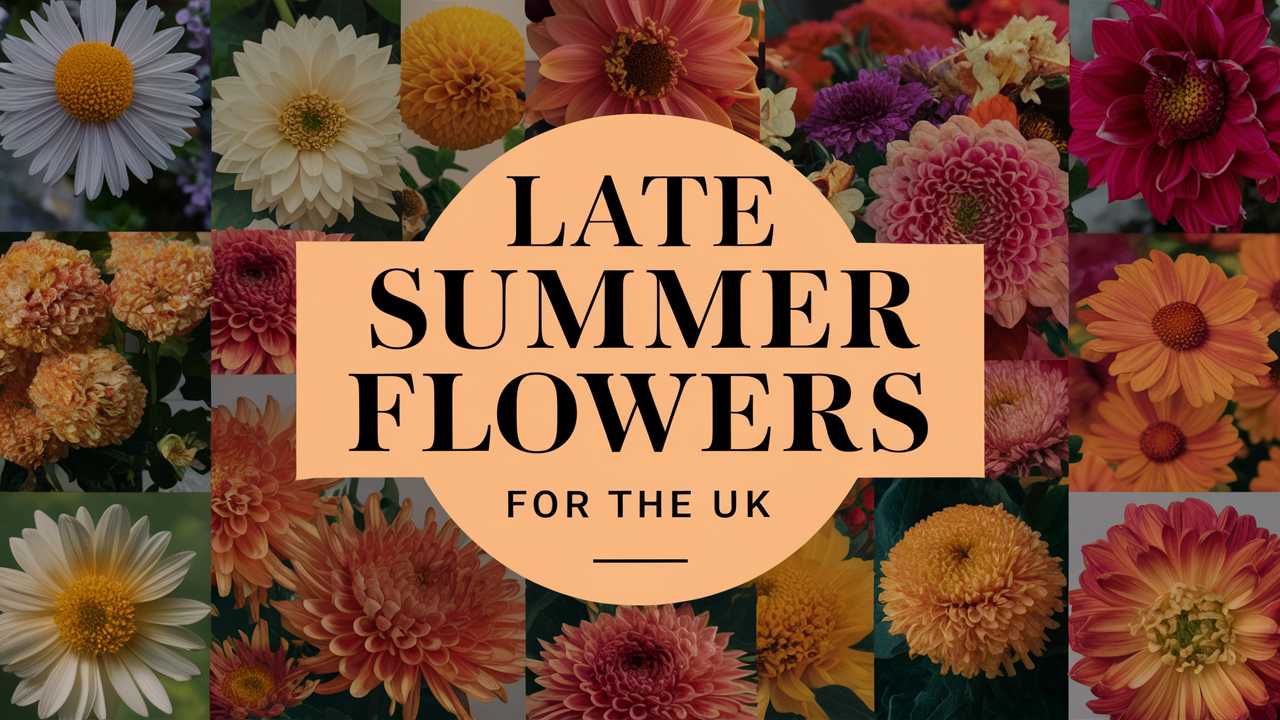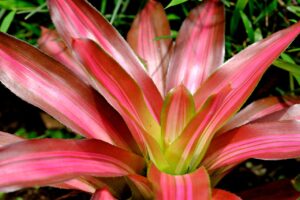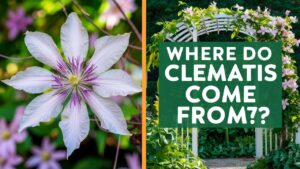In this expansive guide, we will explore an array of stunning flora that truly shines during the late summer months, spotlighting their individual charms and ideal growing conditions.
Lavender (Lavandula angustifolia)
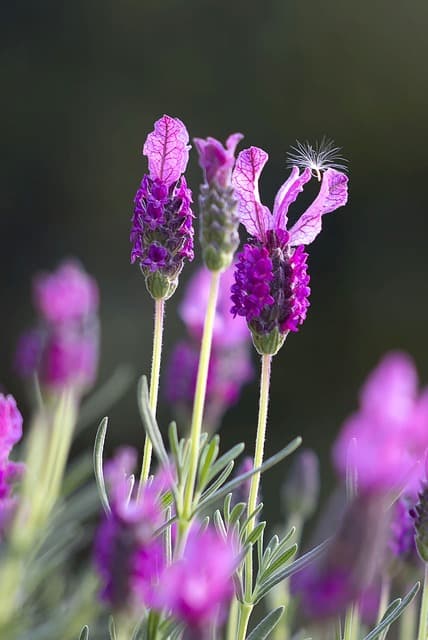
Lavender is an iconic flower that graces UK gardens with its calming fragrance and stunning purple blooms. This hardy perennial is not only beloved for its beauty but also for its versatility; it can thrive in various soil types, making it a staple in both ornamental and culinary gardens. Lavender blooms from late spring through late summer, attracting bees and other pollinators. It prefers well-drained soil and a sunny spot, making it an excellent choice for those hot, sun-drenched days in July and August.
As a late summer flower, lavender continues to provide color and aroma well into the season. Its delicate flowers can be harvested for use in sachets, herbal teas, or even culinary dishes, which adds an extra layer of enjoyment for gardeners. The sight and smell of lavender wafting through the garden can evoke a sense of calm, inviting you to slow down and take in the late-summer ambience.
Roses (Rosa spp.)
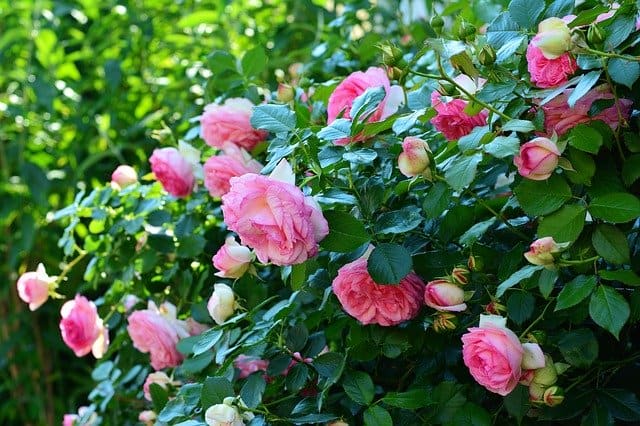
Roses are often considered the quintessential garden flower, flourishing throughout the summer and into the early weeks of autumn. Their diverse range of colors, shapes, and fragrances makes them a versatile choice for any garden setting. Late summer roses, especially reblooming varieties, can provide a second burst of flowers, revitalizing any outdoor space and offering lasting beauty.
For those in the UK, varieties like ‘Gertrude Jekyll’ and ‘David Austin’ roses bloom quite late in the season, presenting lush petals that open to showcase intricate layers. Roses thrive in well-drained soil and benefit from regular deadheading to encourage new bloom development. Their romantic allure and adaptability make them a romantic choice for gardeners looking to brighten their spaces as the season winds down.
Foxgloves (Digitalis purpurea)
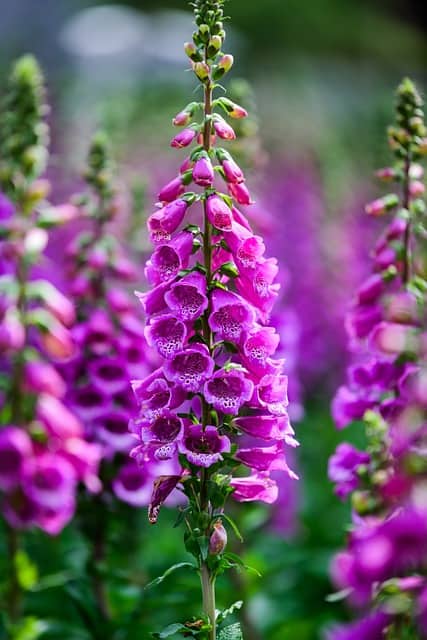
Foxgloves are striking plants that rise tall above other garden flora, with their tubular blooms offering an enchanting display of colors, from soft pastels to vibrant purples. These biennials are often found growing wild in the UK, naturally adorning woodland edges and meadows. Primarily flowering from late spring through late summer, foxgloves are known for their dramatic height and whimsical appearance, making them a fantastic addition to cottage gardens or borders.
Apart from their beauty, foxgloves also attract various pollinators, including bumblebees, adding an essential ecological trait to your garden. While they prefer moist, well-draining soil and partial shade, they can adapt to full sun as well, making them quite versatile. Just be mindful—while they are stunning, they are also toxic if ingested, which calls for cautious placement in family gardens.
Peonies (Paeonia spp.)
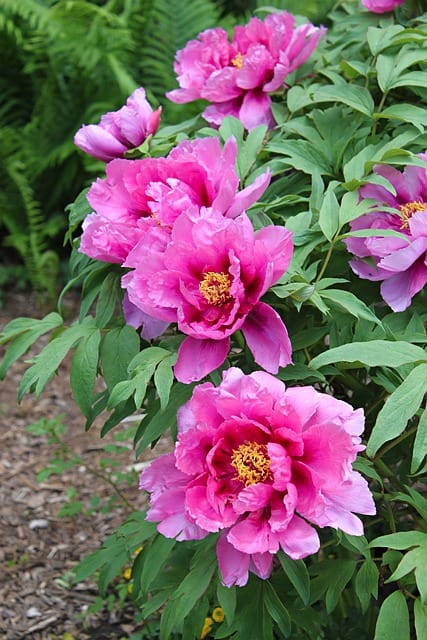
Peonies are sought after for their large, fragrant blooms that embody the essence of summer. These perennial favorites can come in forms ranging from singles to doubles and boast a spectrum of colors, making them a true centerpiece for any garden. Peonies typically bloom in late spring, but with proper planning and careful selection of varieties, you can enjoy their beauty well into the late summer months.
To ensure you’re still admiring peonies during this transitional season, consider planting late-flowering varieties such as ‘Gardenia’ or ‘Coral Charm’, which can bloom into July and August. These lush, full blooms can make fantastic cutting flowers, beckoning you to create stunning bouquets that celebrate the vibrancy of summer. Planting peonies requires patience, as they may take a year or two to establish before producing their majestic blooms, but the wait is undeniably worthwhile.
Alliums (Allium giganteum)
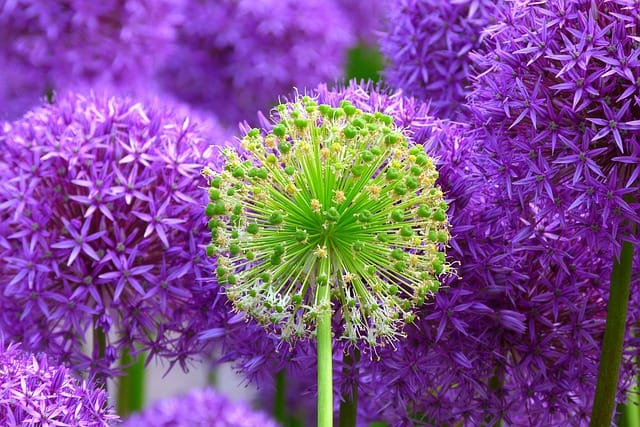
Alliums, with their distinctive spherical flower heads, are a bold choice for the late summer garden, providing a unique twist in contrast to the more common bloom shapes. Allium giganteum stands tall, often reaching up to 4 feet, with its impressive globes of purple flowers that bloom in June and can often linger into late summer. Their architectural structure adds height and drama to any arrangement or garden bed.
These hardy bulbs thrive well in well-drained soil with plenty of sunlight, encouraging a successful growing season. Alliums also make excellent companions in mixed borders, adding interest and striving through various climates. Additionally, their attractive seed heads can add texture and beauty long after the blooms have faded, ensuring that your garden retains aesthetic value even as summer transitions to autumn.
Poppies (Papaver orientale)
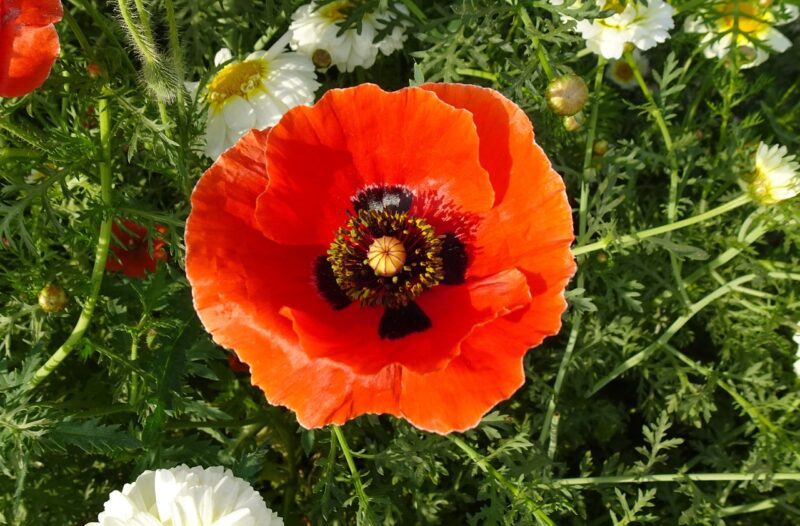
Poppies are iconic for their vibrant petals and ephemeral nature. The Oriental poppy (Papaver orientale) typically blooms in late spring, but it’s worth noting that with proper care, you can encourage subsequent blooms into early summer. Although their window is short, the breathtakingly delicate flowers that emerge in fiery reds, deep purples, and gentle pinks make an indelible impact.
These hardy perennials generally thrive in well-draining soil and full sunlight, making them a popular choice for borders or wildflower gardens. The allure of poppies is not just visual; they have inspired numerous artists and poets throughout history. In your garden, they can offer a poignant reminder of the beauty of fleeting moments, making a lasting impression long after their blooms have melted away.
Mid-Summer Bloomers (July – August)
Whether it’s the hot sun beating down or the gentle summer breeze, mid-summer in the UK is filled with a rich tapestry of colors and fragrances, punctuated by a myriad of blooming flowers. These flowers are not only vibrant but are also vital to supporting pollinators and enriching the biodiversity of your garden.
Sunflowers (Helianthus annuus)
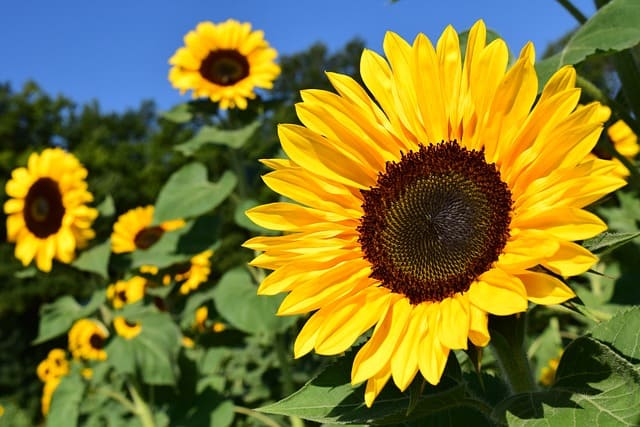
What’s more cheerful than a sunflower basking in the late summer sun? These spectacular blooms can grow tall, towering above other plants and turning their cheerful heads to follow the sun’s arc. Grown from seeds sown directly into the ground, sunflowers thrive in sunny positions with well-drained soil, flourishing with little maintenance as the summer days stretch on.
Sunflowers can present a wealth of delight for your garden. The varieties range from traditional giants to dwarf types suitable for smaller spaces. By late August, many sunflowers will be in full bloom, making them the perfect addition to any cut flower arrangement. Plus, they not only brighten your space but also attract birds and pollinators, supporting the local ecosystem while you enjoy their vibrant views.
Dahlias (Dahlia spp.)
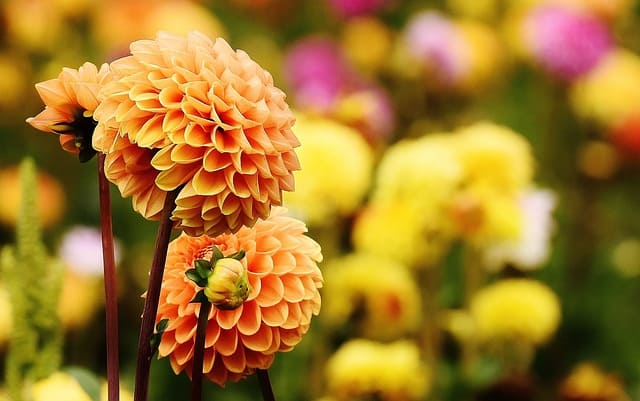
Dahlias are show-stoppers, best known for their incredible diversity, from bushy varieties that create bushy mounds to tall varieties ideal for flaunting in the back of borders. Their blooms can erupt in radiating petals of every conceivable color, boasting a spectacular range of forms and sizes. The dahlia season peaks from mid-summer through to the first frosts, offering prolonged beauty in your garden.
These delights can excel in containers or borders, given adequate sunlight and consistent moisture. Regular deadheading encourages new flowers and prolongs their blooming period, ensuring that your late summer garden remains vibrant. With their impressive variety, dahlias can suit any gardener’s aesthetic, whether you’re after bohemian charm or formal elegance.
Sweet Peas (Lathyrus odoratus)
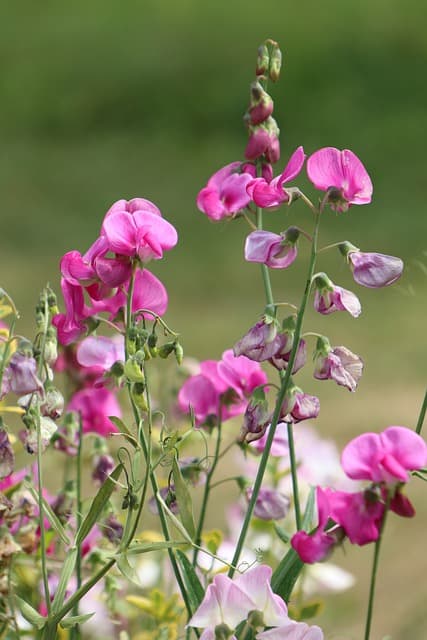
Sweet peas are renowned for their enchanting fragrance and delicate blossoms that make them a popular choice among gardeners. They typically bloom sporadically throughout the summer months, with proper choices leading to a breathtaking late-summer display. Cheery and fragrant, these climbing blooms are perfect for trellises, fences, or as companions to other flowers.
Sweet peas thrive in full sun and well-drained soil, helping them to flourish. They are wonderful for cutting, with their pleasing scent capturing the essence of summer evenings. Growing these simple yet lovely flowers can be a rewarding experience, as they evoke nostalgia and a sense of whimsy that lingers long after their petals drop.
Hollyhocks (Alcea rosea)
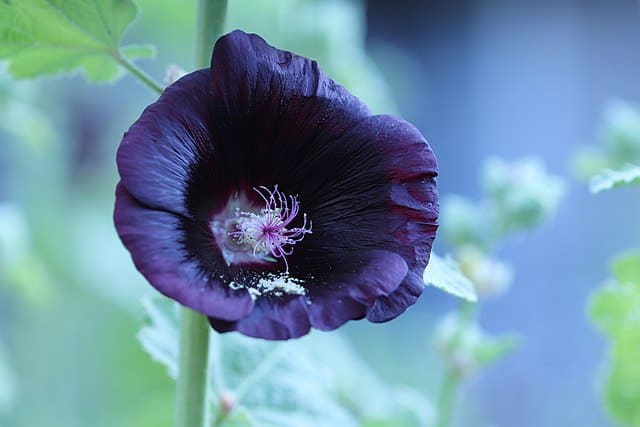
Hollyhocks stand proudly in gardens, known for their tall stalks adorned with funnel-shaped blooms. These biennial plants endure through the late summer, creating vibrant columns of color that can often reach heights of 8 feet or more. Blooming in various hues, including striking pinks, yellows, and whites, hollyhocks can provide a delightful backdrop for any garden space.
Planting hollyhocks against walls or fences allows them to bask in sunlight while receiving casual support. With their historical charm reminiscent of English cottage gardens, they invite passersby to pause and behold their elegance. With time and care, hollyhocks can provide a stunning seasonal display, attracting pollinators and creating a delightful atmosphere.
Coreopsis (Coreopsis verticillata)
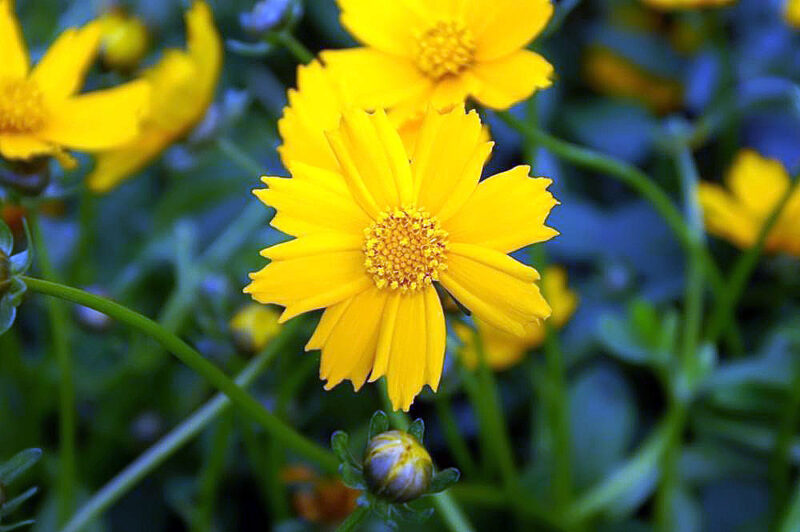
Coreopsis, or tickseed, is a perennial flower known for its bright, cheerful golden-yellow flowers. These resilient beauties bloom extensively from July through September and are highly adaptable, growing well in various soil types, including poor, dry-upon soils. Given their sun-loving nature, they thrive in full sunlight, making them an excellent choice for late summer.
The blooms attract butterflies and bees, adding joyous life to your garden. Their compact form makes them perfect for borders, containers, or mass planting, making an excellent floral tapestry that catches the eye. In cutting arrangements, coreopsis brings a burst of sunlight indoors, brightening up any room with their golden hues.
Salvia (Salvia nemorosa)
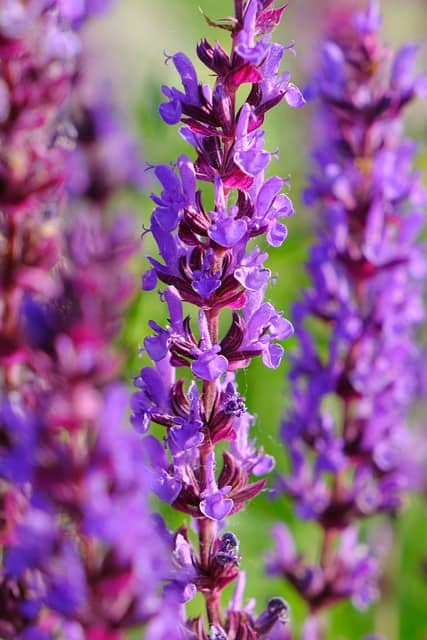
Known for their spiky flower heads and aromatic foliage, salvias are perennials that are undoubtedly a staple in late summer gardens. Salvia nemorosa, in particular, blooms from July all the way into autumn, offering spikes rich in lilac to blue hues. They are superb pollinator attractions, drawing in both bees and butterflies, making them indispensable for biodiverse gardening.
These drought-resistant plants thrive well in sunny conditions and can be easily maintained through regular pruning and deadheading. Their resilience and hardiness ensure a vibrant garden throughout the summer heat, and their elongated spikes add height and motion as they sway in the gentle breeze.
Zinnias (Zinnia elegans)
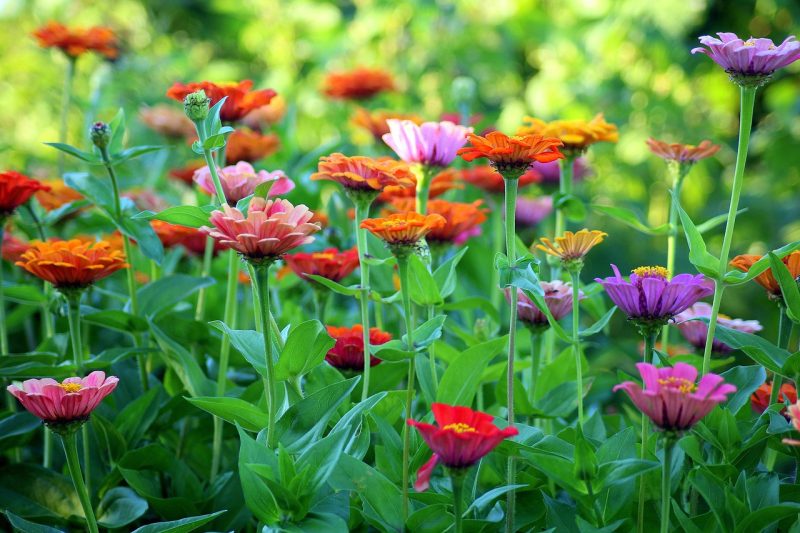
Zinnias capture attention with their bright colors and long-lasting blooms that span from summer into early fall. With a variety of sizes and shapes, zinnias can host a show-stopping display of hues ranging from deep reds to brilliant oranges, all providing essential appeal and warmth to gardens and arrangements alike.
These annuals thrive in well-drained soil and full sunlight, making them easy to grow and incredibly rewarding. Zinnias are particularly loved for their ability to attract butterflies, creating a dynamic atmosphere in your garden. Besides their ornamental value, they make vibrant cut flowers, bringing a youthful burst of color to both indoor and outdoor spaces.
Late Summer Bloomers (August – September)
As summer edges towards autumn, a different bouquet of flowers emerges, flourishing later in the season. These late summer bloomers tend to embody rich color and textured depth, forming a captivating panorama that serves as a bridge between the seasons.
Echinacea (Echinacea purpurea)
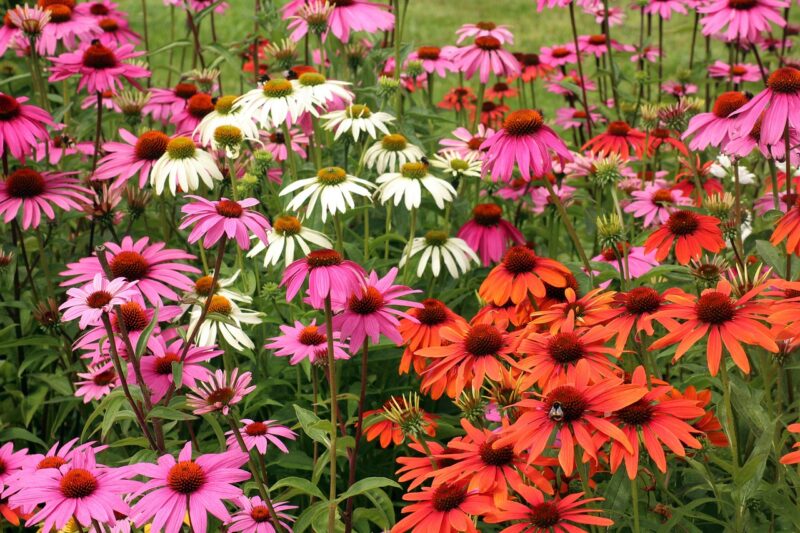
Echinacea, often called coneflower, is an iconic late summer bloomer that thrives in the UK, showcasing bright pink or purple daisy-like flowers that rise above dark green foliage. The blooms typically appear from July and peak through early autumn but can hold their beauty even later with proper care.
Moreover, echinacea is not only stunning but beneficial. Known for its medicinal properties, the flower can be a boon for health, often used in herbal remedies for boosting immunity. As garden favorites, these resilient plants thrive in well-drained soil and full sun, making them ideal for mixed borders or as standalone features in naturalistic gardens.
Black-Eyed Susans (Rudbeckia hirta)
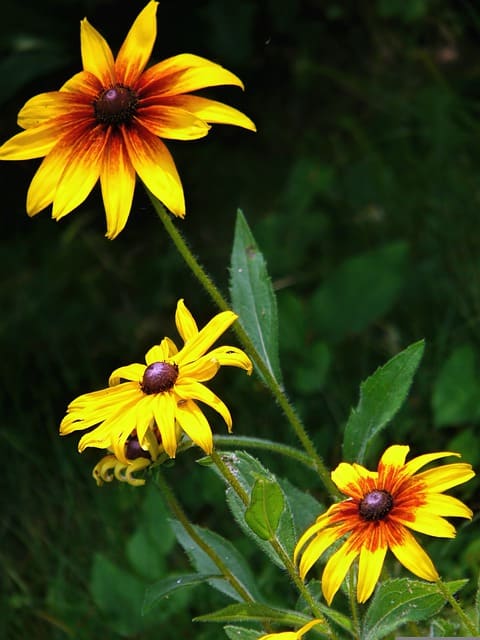
Black-eyed Susans are a steadfast, cheerful flower that adds warmth to any late-summer garden. Their distinctive yellow petals surround a dark brown or black center, creating a stunning visual contrast. These hardy annuals or perennials bloom from July and last into September, drawing in pollinators and bees with their nectar-rich flowers.
In terms of cultivation, black-eyed Susans flourish in sunny spots with well-drained soil, thriving with minimal maintenance. They are ideal for borders or wildflower areas, lending a rustic charm to a garden while seamlessly transitioning into autumn’s embrace.
Cosmos (Cosmos bipinnatus)
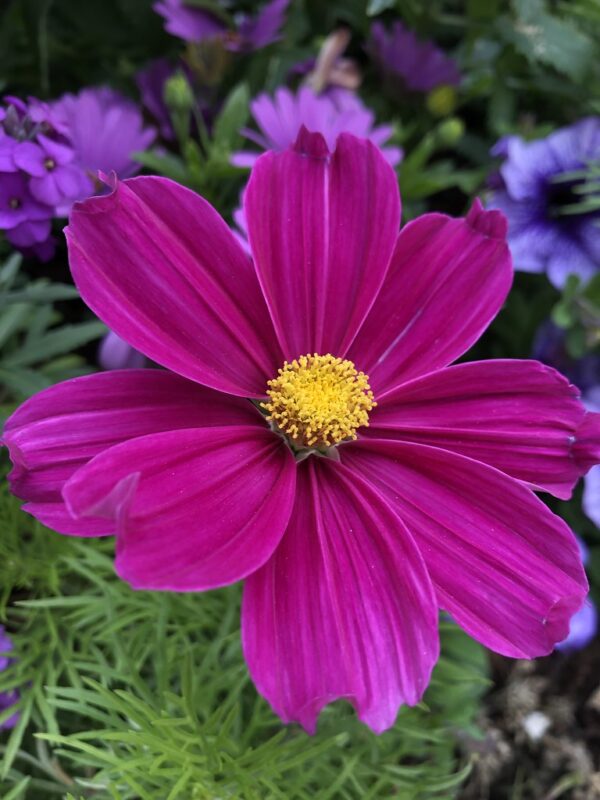
Cosmos are cherished for their delicate, feathery leaves and dainty flowers, which bloom in a variety of colors, from pure whites to bright pinks and deep reds. Originating from Mexico, these annuals thrive in the UK during the summer months, often starting in mid-summer and continuing to bloom through September.
Easy to grow and tolerant of poor soils, cosmos add whimsy to any garden. These flowers are known for attracting butterflies, creating an enchanting display throughout the late summer months. Their lightweight and gracefulness evoke a carefree spirit, making them a favorite for any gardener seeking effortless beauty.
Japanese Anemone (Anemone hupehensis)
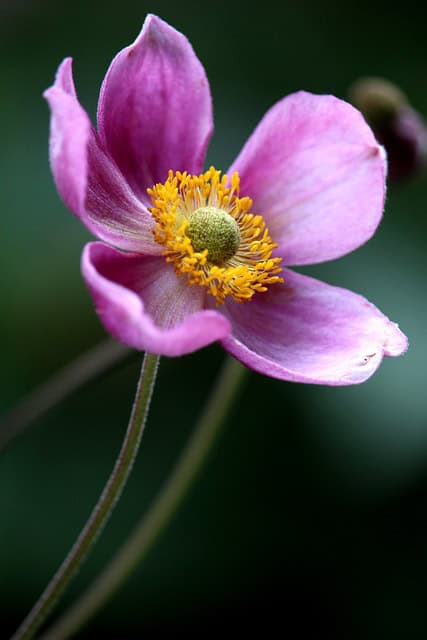
The Japanese anemone is a graceful perennial that begins its late-summer show, stretching its delicate, cup-shaped blooms into the autumn months. With their soft, pink or white petals and bright yellow stamens, they bring an ethereal quality to gardens, representing the transition from summer to fall.
They thrive in partial shade but can also manage well in sunny spots with sufficient moisture. Japanese anemones can create beautiful woodland plantings or stand alone as remarkable specimens in borders, offering elegance and charm that soften the edges of the changing season.
Verbena (Verbena bonariensis)
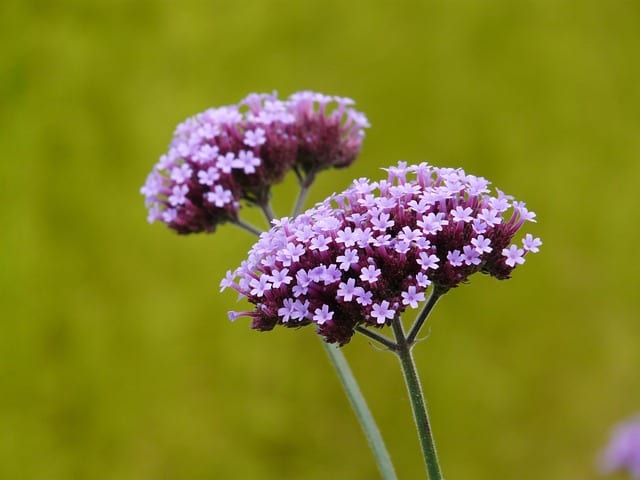
Verbena is notable for its long clusters of tiny blossoms that attract butterflies and hummingbirds alike. This perennial blooms abundantly from mid-summer through to late autumn, presenting a stunning show of purple and lavender shades that dance in the breeze, effectively linking various garden elements together.
These tall plants are perfect for creating a soft edge around borders or in perennial beds and prefer full sun and well-drained soil. Verbena’s resilience allows them to thrive in drought conditions, making them a low-maintenance option for busy gardeners. Moreover, they look breathtaking in cut flower arrangements, capturing the essence of late summer.
Gladiolus (Gladiolus spp.)
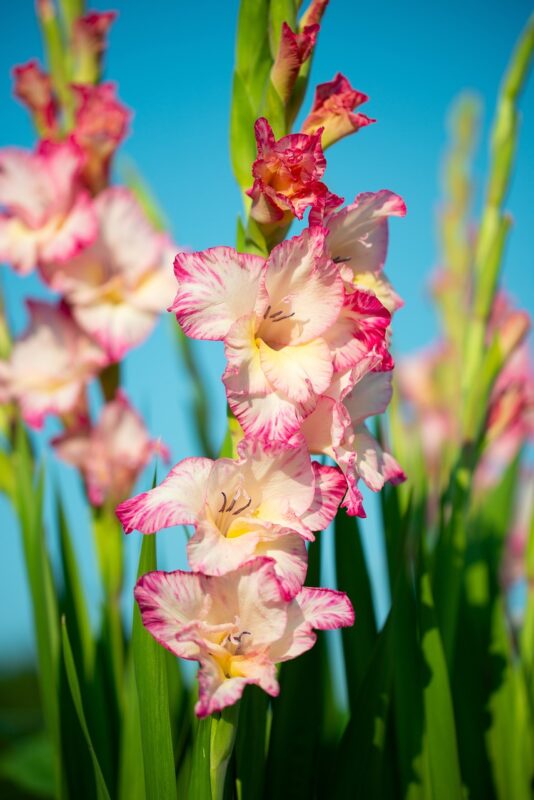
Gladiolus, with its tall spikes of trumpet-shaped blooms, is a classic late-summer beauty that never goes unnoticed. These dramatic flowers thrive during the warm months, often blooming in vibrant colors such as pink, yellow, and red. Gladiolus are typically planted as corms in the spring, giving them ample time to mature and display their lavish petals from July to September.
They prefer full sun and well-draining soil, ensuring their needs are met. These flowers are excellent choices for creating bold cut flower arrangements, instantly adding flair and elegance to your home decor. Their commanding height and vibrancy make them a fantastic addition to any late summer garden, ushering in the change of seasons in style.
Asters (Aster novae-angliae)
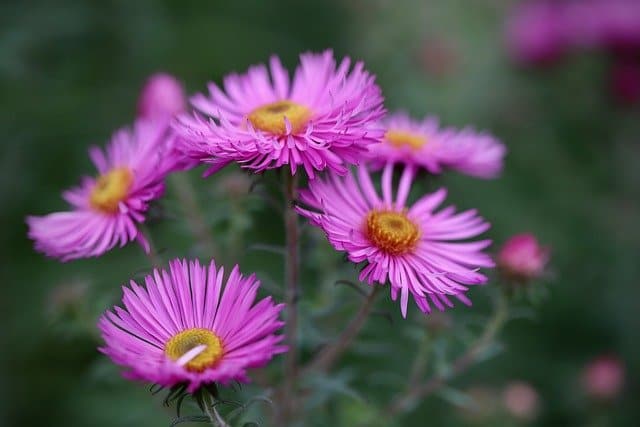
Asters are most synonymous with the changing colors of autumn, but they start to bloom late in the summer, offering a much-needed burst of color just as the season transitions. The classic purple and blue shades of asters symbolize resilience and beauty, drawing in butterflies and pollinators as summer gives way to fall.
These perennials thrive in well-drained soil and full sunlight, making them straightforward to incorporate into any garden design. Asters can be stunningly effective as a backdrop in mixed borders, and their long-lasting blooms make them excellent for cutting and bringing indoors. With consistent deadheading, they can offer extended beauty, enhancing the charm of late-summer landscaping.
Liatris (Liatris spicata)
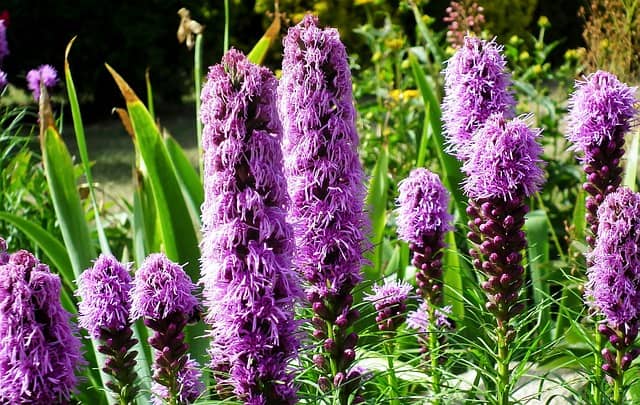
Liatris, often called gayfeather or blazing star, brings unique verticality to late-season gardens. Its feathery flower spikes bloom from the top down, showcasing bright purple blooms that catch the eye. This perennial thrives from mid-summer through the onset of autumn, making them a favorite for bringing drama to garden beds.
Liatris prefers full sun and well-drained soil, thriving in less fertile settings. Their height and structural form create exciting contrast with shorter plants, making them indispensable in perennial borders. Additionally, these flowers are beloved by bees and butterflies, making them an excellent choice for pollinator-friendly gardens.
Gaillardia (Gaillardia x grandiflora)

Also known as blanket flower, Gaillardia offers a riot of colors that spans from red to orange to yellow, exuding warmth and vibrancy in the late summer garden. These cheerful blooms are hardy perennials that thrive in varying soil conditions, blooming extensively from mid-summer and maintaining their vibrancy until the first frost.
Yes, gaillardia loves the sun, requiring little maintenance, making them perfect for busy gardeners or as colorful additions to a more wildflower-themed setting. They are wonderful for creating masses of color and can significantly contribute to the summer garden’s exuberance and vitality.
Nasturtiums (Tropaeolum majus)
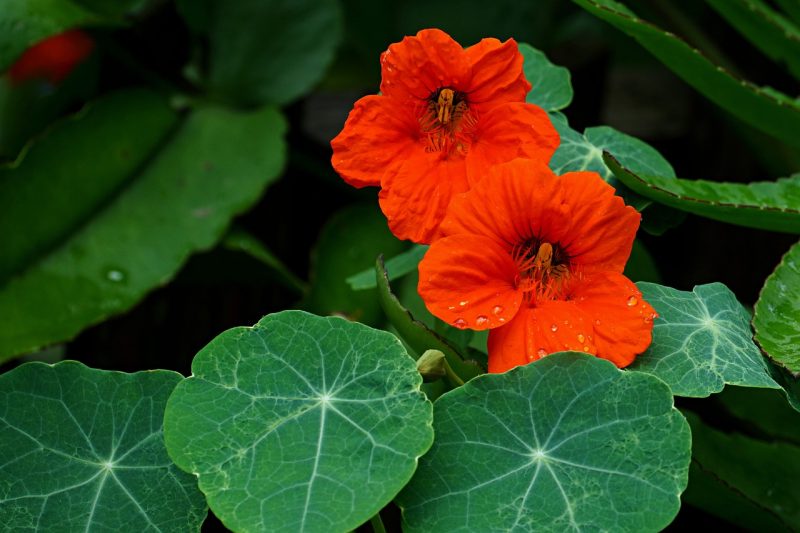
Nasturtiums are superb for late summer foliage and blooms, charmingly cascading or climbing. With their edible leaves and vibrant flowers, these annuals can bring both beauty and function into your garden. Their distinct orange, red, and yellow petals bloom from early summer and can continue well into the fall, providing bold color just when the weather begins to cool.
Ideal for mixed plantings, nasturtiums thrive in various soil types but prefer poorer soils, allowing their vibrant colors to shine. Plus, their leaves and flowers are entirely edible! Adding these unique beauties to salads or as garnishes adds a distinct flavor while enhancing your late-summer culinary adventures.
Marigolds (Tagetes spp.)
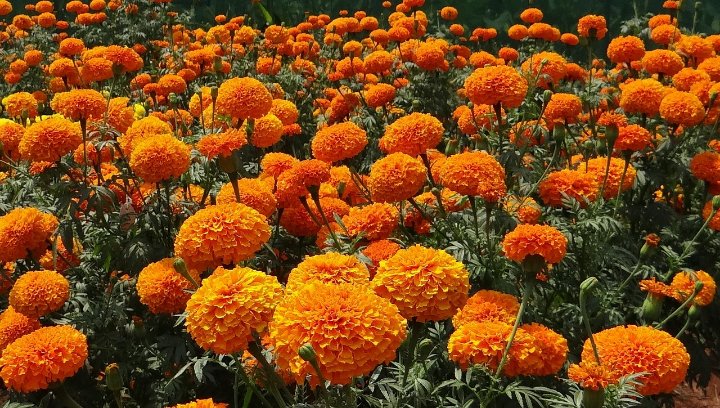
As humble as they are beautiful, marigolds are perfect for late summer blooms. Known for their bright yellows, oranges, and reds, marigolds showcase a long blooming period, extending well into the autumn if properly cared for. They act as guardians in the garden, naturally repelling pests while attracting beneficial insects.
Marigolds thrive in full sunlight and are remarkably adaptable, making them ideal for container gardening or borders. These sturdy annuals provide a cheerful splash of color, lending warmth and brightness to any plot. Whether used to accompany vegetables or adorn flower beds, marigolds are a beloved staple in many UK gardens.
Petunias (Petunia x hybrida)
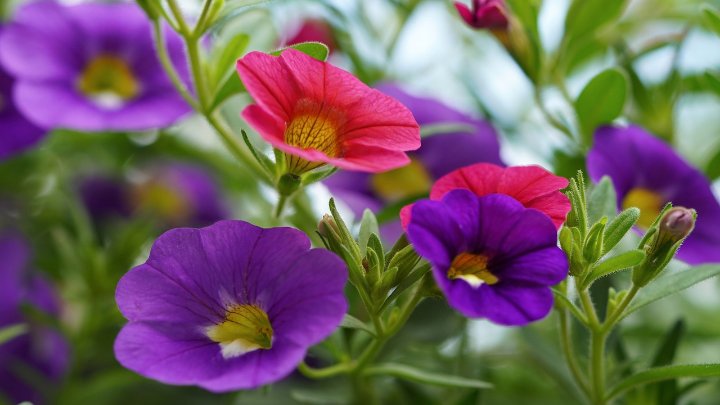
Petunias come alive in late summer, presenting a vibrant display of colors and fragrances. These versatile annuals can be planted in garden beds, hanging baskets, and containers, making them perfect for a variety of settings. With an impressive range of colors and patterns, petunias can cater to any aesthetic in your garden.
They love full sun and flourish with regular watering and fertilization, ensuring long-lasting blooms. As summer approaches its end, their fragrant flowers continue to inspire joy, inviting you to spend leisurely evenings outside as the sun sets. Petunias can bring a lively flair to your outdoor spaces, making them a wonderful choice for late summer gardens.


